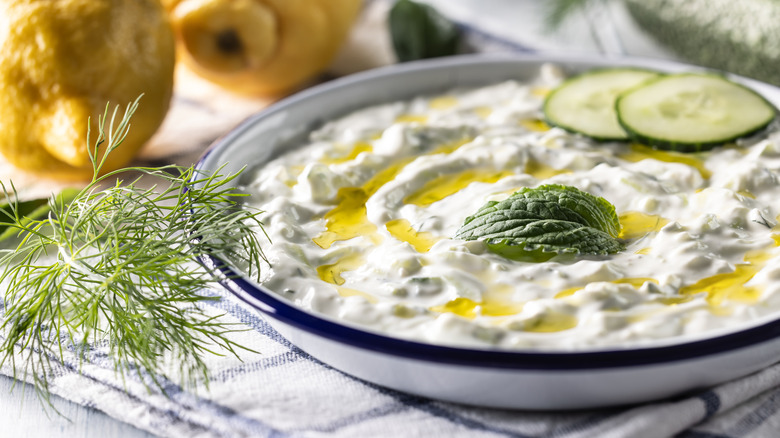Tahini Vs Tzatziki Sauce: Here's The Actual Difference
While both tahini and tzatziki are known for their creamy texture and versatile uses, the similarities between these two sauces with Mediterranean and Middle Eastern roots don't extend much further than that. Tahini, also sometimes referred to as tahina, is a light beige paste made from sesame seeds and used both as an ingredient and a sauce. After being toasted, ground, and combined with oil, the sesame seeds become smooth, creamy, and pourable. Tzatziki is a mix of cucumber, garlic, lemon zest, lemon juice, and fresh dill combined in a whole milk Greek yogurt base and often seasoned with kosher salt and black pepper.
Either looking at these ingredients or comparing these sauces with a side-by-side taste test easily reveals how the bright and tangy flavors of tzatziki are a strong contrast to the savory, nutty flavor of tahini. Beyond the flavors, the different ingredients of these sauces have an impact on the nutritional value of these sauces. The yogurt base of tzatziki makes it a boon for probiotics (assuming you use a yogurt with live cultures), while the olive oil and herbs also serve as flavorful sources of healthy fats and antioxidants. The sesame seed base of tahini provides its own serving of healthy fats, along with calcium, iron, and other beneficial vitamins and minerals, with the added perk of being dairy- and gluten-free. These differences in ingredients, flavor, and nutrients have further implications for the ways these sauces are used when it's time to cook.
Harnessing the flavors of tahini
Besides adding a nutty flavor to banana cream pie and other desserts, tahini also works well when it's served with either cooked or raw vegetables. Tahini provides a sturdy base that allows the flavor of fresh vegetables to pop, such as in a raw kale and toasted pumpkin seed salad or a simple serving of sliced tomatoes and cucumbers. The smokiness of a grilled eggplant or sweetness of a roasted carrot, on the other hand, are delightfully contrasted by the subtle nuttiness of tahini. This sauce works just as well when served with proteins like chicken and lamb.
While tahini is already delicious with the most basic ingredients, other components can be added to complexify the flavor. Adding lemon juice, cumin, salt, and a bit of water to tahini, for example, is an easy way to upgrade the sauce with a pop of citrus without compromising the creamy texture. Additionally, gradually mixing in grated garlic adds an element of sharpness and funk. You can count on herbs like parsley, chives, mint, and cilantro to liven up the tahini with fresh, aromatic flavors. Its ability to make other ingredients shine in any dish makes tahini a valuable addition to countless meals across many cuisines.
Taking the taste of tzatziki to new heights
Depending on the region, tzatziki can take on a variety of forms. In the Balkans, for example, it's known as tarator and sports a texture that's thin enough it arguably falls into the soup category (as does a Turkish variation known as cacik). It also often features the earthy flavors and additional fats of walnuts. Regardless of the different names and ingredients tzatziki may take on when made in different regions, the combination of yogurt, cucumbers, garlic, and fresh herbs will create a flavorful accompaniment for putting a Mediterranean spin on a cottage cheese flatbread or crunchy tuna salad sandwich.
While tzatziki is flavorful enough to serve as a dip for raw vegetables, pita chips, or falafel, you can also count on this sauce to add a pop of freshness to proteins like roasted chicken or salmon. In fact, tzatziki is a boon for most grilled meats thanks to the heat and acidity provided by the garlic and lemon juice. The variety of ingredients at play in tzatziki creates an inviting and complex field of flavor to experience and experiment with when it comes to your own flavorings. If you want to quickly upgrade your tzatziki at home, consider adding in olive oil, oregano, and fresh mint or lightly topping it with za'atar for a boost of flavor.


